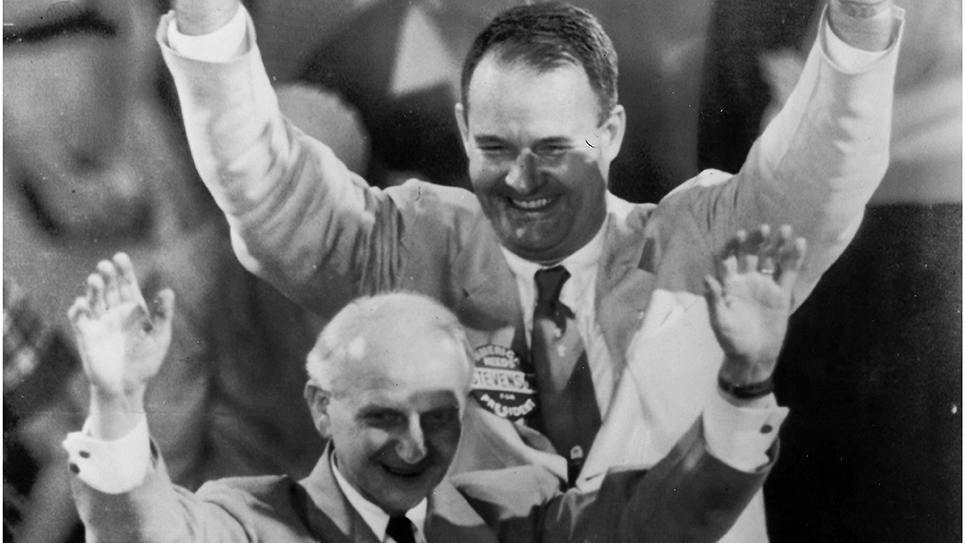The Governor: Elbert Carvel of Delaware
At six feet and six inches, Elbert N. “Bert” Carvel was impossible to miss. For a quarter of a century, Carvel was a political force to be reckoned with inside the First State. Carvel’s success in business – – – he manufactured fertilizer – – – made for many jokes which are better left unprinted. The first lieutenant governor in Delaware to be elected to the governorship, Carvel remains the only person ever to be elected to two non-consecutive terms as Delaware’s chief executive.
A jovial man who liked people, Elbert Carvel had a number of things he loved in life; public service, through which he was able to help others, and classical music, a love he shared with his four children, were important to him. Carvel also loved his home church, St. Philip’s Episcopal Church in Laurel, Delaware. In 1968, when some young Democrats were attempting to reorganize their party, Joe Biden was tasked with telephoning former Governor Carvel. “I can’t call him!’ Biden cried. “He’s a governor and I’m nothing.”
Biden learned the former governor was a cordial man who made callers feel welcome. The future senator readily acknowledged “it was like we’d been friends forever” when they had a conversation.
Born in New York, Carvel was reared and educated in Maryland. What brought “Big Bert” Carvel to Delaware is what has likely moved more people than any other single thing throughout the history of the world: love. Carvel married Ann Valliant in 1932 and entered the family business of manufacturing fertilizer. Eventually, Carvel founded his own company and became the largest stockholder in both companies before selling the businesses in the 1970s. Elbert Carvel had earned a law degree, which came in handy, but throughout his life, he was more a successful businessman than a practicing attorney. A man who had a sensitive side, Carvel was known as a man of his word, something that is elusive in politics and life these days. Elbert Carvel would not cut corners where one of his personal principles was involved merely for the sake of political popularity.
As Carvel began his campaign for governor in 1948, he would invite folks over for dinner and produce root beer and cheese to the astonishment and horror of his guests. Democrats had fared well, as many Democrats did throughout the country, throughout the Age of Franklin Roosevelt and the New Deal, and that was certainly true in Delaware. The pendulum began to swing back to the Republicans when former Governor C. Douglass Buck won the U.S. Senate seat occupied by Democrat James H. Hughes in 1942. In 1946, Republican John J. Williams beat Senator James M. Tunnell in what was a great year for GOP candidates nationally. Republicans had won both houses of Congress that year under the leadership of Tennessean Carroll Reece, who was the chairman of the Republican National Committee. Just about every national commentator and political prognosticator in the country believed 1948 would be an even better year for Republicans. Thomas E. Dewey, the diminutive, dapper and mustachioed governor of New York, was considered by virtually every leading light in the United States to be the president-in-waiting.
The only seeming dissident to the prevailing opinion was Harry Truman, who waged a frequently lonely but fighting campaign, denouncing the productive Congress as “the do-nothing Congress.” Several times, Truman shrewdly baited the Republicans, not the least of which was his calling a special “Turnip Day” session of Congress after giving the Republicans a want-list of legislation to pass. Of course, the GOP legislators were not about to pass a laundry list of bills for Harry Truman.
While Thomas E. Dewey carefully talked in generalities and spouted platitudes, Elbert Carvel was running an energetic campaign for governor. Having been elected lieutenant governor in 1944, the 34-year-old candidate had won by exactly 453 votes out of more than 120,000 cast. Carvel and his running mate, J. Allen Frear, who was running against Senator Buck, ran hard. Tom Dewey did indeed carry Delaware, but only by 1,775 votes. Frear upset Senator C. Douglass Buck while Carvel beat GOP gubernatorial nominee Hyland P. George by more than 10,000 votes, carrying all three of the First State’s counties.
During his governorship, Elbert Carvel was strongly against the use of capital punishment. Carvel’s belief was anchored in his own Christianity, believing that while God may exact vengeance, man may not. Delaware’s General Assembly overrode Governor Carvel’s veto of a capital punishment bill after an especially grisly murder, which had ironically occurred in Carvel’s hometown. His Christian values caused him to insist upon returning good for evil as well. “Don’t hold grudges,” Governor Carvel frequently advised associates, oftentimes to their dismay.
Oddly, when Elbert N. Carvel became governor, Delaware had no state supreme court. That threatened Delaware’s status as a tax haven for some of the biggest corporations in the world. Governor Carvel pushed to create a supreme court for the First State.
The governor was also a crusader and outspoken advocate for civil rights throughout his political life. It is well to keep in mind that Delaware was a segregated state when Elbert Carvel was first elected governor. It was during his second term as governor that Carvel appointed a Human Relations Commission and pushed the reluctant General Assembly hard to approve a public accommodations bill in 1963. The Reverend Maurice Moyer, who was the head of the Wilmington branch of the NAACP, praised the governor, remembering him years later. “He was a big man and he had a big heart,” Reverend Moyer said.
Robert F. Gilligan, the House minority leader in Delaware at the time of Elbert Carvel’s death, said of the former governor: “He was liberal when it wasn’t politically popular or politically correct to be a liberal.”
It was Governor Carvel who caught Senator Curt Steen, one of the most influential members of the Delaware State Senate, hurrying out of the Chamber, clearly intending to skip the vote on the public accommodations bill. “Curt, where in the hell are you going?” Carvel’s voice boomed throughout the legislative hall. The sheepish Steen looked at Carvel for a moment and then cried, “Governor, if I vote for that bill, they’ll hang me when I get back to Dagsboro.” “Hang and be damned,” Governor Carvel snapped. Curt Steen went back into the Senate Chamber and voted for the public accommodations bill.
During Elbert Carvel’s electoral career, Delaware was most certainly a swing state. When Governor Carvel sought a second term in 1952, the tide was rising for Republicans. Dwight D. Eisenhower, almost certainly the most popular individual in America, was the GOP presidential candidate. Delaware Republicans had also nominated their most popular statewide official to run for the governorship in Congressman Caleb Boggs. The congressman had been the only statewide Republican candidate to survive the 1948 defeat. Carvel’s liberalism wasn’t as welcome in a Republican year, and Boggs beat the governor by 7,205 votes.
Few observers believed Elbert N. Carvel was done with politics. For six years, Carvel concentrated on his business interests, but he kept his hand in politics and remained active. It was 1958 when the former governor announced he would try to make a comeback by challenging Senator John J. Williams, who was seeking a third term in the United States Senate. The former governor had been critical of Senator Williams, who had earned a well-deserved reputation as the Senate’s best inquisitor. “Honest John” Williams was frequently lauded for having rooted out corruption during his 12 years in the United States Senate. Some of the corruption Williams had ferreted out involved unions, which made the senator an intensely disliked figure with much of organized labor.
Elbert N. Carvel was the consensus choice to run against Senator Williams, and the campaign was hard fought. Delaware Democrats made an all-out assault upon the political record of Senator John J. Williams. While Democrats waged a scorch earth campaign against Senator Williams, the Republican senator was a resourceful campaigner who paid close attention to the needs and concerns of his constituents, making him a difficult target. The country was in the middle of a recession, and 1958 was a terrible year politically for Republicans, who lost 13 seats in the U.S. Senate. That of John Williams was not one of them. The senator carried all three of Delaware’s counties and beat former Governor Carvel by more than 10,000 votes.
Two years later, Elbert N. Carvel announced he was running to reclaim the governorship. Incumbent Cale Boggs was running against Senator J. Allen Frear. The people of Delaware showed they knew how to split tickets as John F. Kennedy narrowly beat Richard Nixon by just over 3,000 votes. Elbert Carvel won the governorship, beating Lieutenant Governor John W. Rollins by 6,749 votes. Cale Boggs proved yet again that he was able to buck the tide, ousting incumbent Senator J. Allen Frear by 2,784 votes.
At the conclusion of his four-year term as governor, Elbert N. Carvel opted not to seek a second consecutive term, which he almost certainly would have won. Instead, Governor Carvel sought a rematch with popular Senator John J. Williams in 1964. Once again, the campaign was hard fought down to the last vote. Governor Carvel believed during the last week of the race that he would win.
While Lyndon Johnson was swamping Barry Goldwater by more than 44,000 votes in Delaware, John Williams yet again demonstrated his personal popularity with the people of the First State, winning reelection by just under 7,000 votes and again carrying all three of Delaware’s counties. In a telephone call with President Lyndon Johnson, Governor Carvel attributed his defeat to having been “cut” by Democrats throughout the state.
Governor Carvel acknowledged that Williams retained a formidable national image for his continuous search for waste and corruption. That national reputation was too much for him to overcome, Carvel said. “The people decided to return a nationally known senator,” Carvel thought. “I enjoyed the campaign. I feel no bitterness toward my opponent nor toward anyone else. I have only gratitude for serving four years (as governor) and for the associates who did so much to help me with the campaign,” Carvel stated.
Asked if he would accept a federal appointment of some kind from President Johnson, the governor replied, “It depends on the job.” “I’m not looking for a job,” Carvel said firmly. “If my country or state ever needs me in any capacity, I’ll do what I can to help.” The governor emphasized he would be happy to return to his business.
Elbert N. Carvel did exactly that and assumed the status of an elder statesman of his political party for the next 40 years. There is much good to be said for being an elder statesman rather than an active officeholder. For decades, Elbert Carvel imparted the accumulated wisdom of his years and experiences to a host of young Democrats who made their way to his office and home.
It is certainly true time stands still for no man, and Elbert Carvel was no exception. The 94-year-old former governor was confined to a wheelchair at a ceremony dedicating the new agricultural conference center in Georgetown, Delaware. Carvel and his wife Ann had donated a hefty sum towards the completion of the center, and the old political warrior managed a smile and a wave to the crowd.
Throughout his long life, Elbert N. Carvel never forgot his father’s insistence that a person should always remain busy and have things to do and remain occupied. Carvel tried to follow that advice until the last few weeks of his life, when he finally let go. The former governor died three days shy of his 95th birthday. Governor Elbert Carvel was buried on the shores of the Chesapeake Bay, laid to rest in a family plot near the family farm he loved so well for decades.
At the time of Carvel’s death, Governor Ruth Ann Minner recalled, “The biggest lesson Bert taught me was to look in your heart and do what you think is right.” © 2025 Ray Hill






